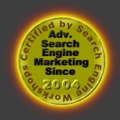 Look how old this is!
Look how old this is! I post at SearchCommander.com now, and this post was published 16 years 1 month 7 days ago. This industry changes FAST, so blindly following the advice here *may not* be a good idea! If you're at all unsure, feel free to hit me up on Twitter and ask.
These days, having varied anchor text is more important than ever, and I’ve released a new link variance tool to make it a bit easier, and a lot faster for your writers.
If you’re an SEO that’s distributing content throughout the web, you should know by now that having too many inbound links with a certain phrase can actually be harmful, and not helpful.
Oddly, many SEO’s are still “playing by the old rules”, and are mistakenly building hundreds of links with similar or identical anchor text in their desire to improve rankings.
The reality is that you do need to ensure that you have a good balance of anchor text coming into the various sections of your website, and they should NOT all say, “blue widgets” anymore. Any exception to this rule would really only be on your own site.
Not only do you want to ensure that you have a good mix of inbound links, but you should include phrases like “check this out” and “look at this” so that they appear to be much more natural.
To be 100% clear, (it’s my belief that) not all of them should come from the body text of relevant articles, and some should come from weird places with crappy phrases.
Some of your links should be no followed too, because otherwise it looks artificial as well. Think about it – If everybody links to you with the exact same anchor text, it becomes painfully obvious that you are building links with the intention of improving your rankings.
So let’s say you have a giant website, with dozens of potential link targets, and dozens or even hundreds of potential phrases. How can you efficiently cover all the bases?
When writing content yourself, or assigning content to employees, or even outsourcing large batches of content to other authors, it’s customary to define the anchor text and landing pages you wish to have them link to in their writing.
Th old way was to tediously hand build link after link, with different anchor text, different landing pages, some followed, some no followed, and give them to authors to start sprinkling in the content.
We recently needed to create over 800 pieces of content, with a few links in each one, and we needed to link back to 30+ different URL’s with tons of different anchor text, and “doing it manually” was just not a viable option.
Rather than create all of the links by hand, we were able to use our PPC Keyword list multiplier and split half of the code for the links in one column, then put half of the code in the second column, creating an output including all of the varied URLs and anchor text.
Of course, because my keyword multiplier placed spaces between the phrases, we then had to do a batch find and replace to fix all of the links, but in the end, we were able to create a massive list of code, with every possible variable of anchor text and landing page that we wanted.
It occurred to me that rather than try to manipulate that tool, and be forced to use find and replace, it shouldn’t be all that much more difficult to create a separate tool and that’s what we’ve done.
Simply place your list of URLs on the left side, place your anchor text variables on the right, then choose whether you want them to be nofollowed or to open in a new window, and press the button. Try it out here




















Nice tool! Be using it often. Thanks Scott! 😉